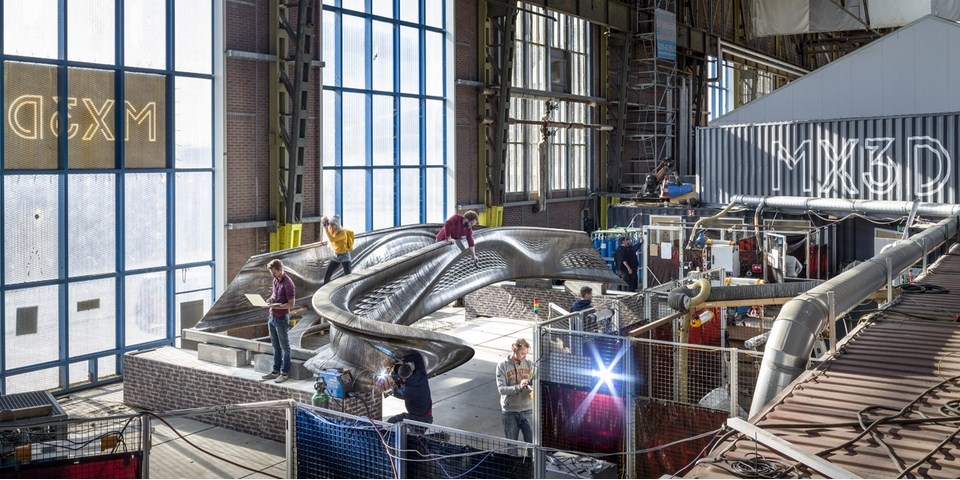Spanning one of the oldest canals in the city, the bridge is the creation of MX3D and a host of partners. MX3D first announce its plans to create a fully functional, 3D printed metal pedestrian bridge in 2015. In April 2018, following six months of printing by four industrial robots, the span section of bridge was finally finished. The bridge is scheduled to be installed in 2019, where it will stretch across Oudezijds Achterburgwal, one of the oldest and most famous canals in Amsterdam, the Netherlands.
Multi-axis robots
The project was used to showcase the potential of using multi-axis robots to 3D print strong, complex and graceful structures out of metal. The robots were equipped with purpose-built tools and controlled with purpose-designed software. The bridge measures 12.5 metres (41 feet) in length and 6.3 metres (20.7 feet) in width. The design includes 4,500 kilograms (9,920 pounds) of stainless steel, and is made of over 1,100 kilometres (683.5 miles) of wire. The next step in the project is performing structural tests on the finalised bridge, scheduled for summer 2018. Later this year, the rest of the bridge, including the swirls, will be printed with the entire bridge scheduled to be revealed in October. Finally, the bridge will be installed in Amsterdam in 2019.
Overcoming challenges
The project encountered some serious challenges along the way. In July 2016 it was discovered that the engineering software used to address the various functional and safety requirements could not handle the complex geometry. Additionally, there remained many unknowns including how much stress the medieval canal walls could withstand, and the near impossibility of defining the material properties of the printed geometries.
This meant the team had to start all over again, this time redesigning to reduce complexity and avoid tension stresses as much as possible. By November 2016 the team had employed an entirely new approach. The team began discussing a sheetconstruction approach rather than the previously-attempted one centred around volume optimization. The benefits of the sheet concept were that it works primarily with compression forces using stress analysis software to generate force lines through the object.
A highly detailed 3D scan demonstrated that the bridge heads are not entirely parallel. As a result of this newfound information, it was decided to give the bridge an asymmetrical shape. This increases the dynamic shape and allows to show that our proprietary technology is not bound by traditional, symmetrical forms. By making the entire bridge design parametric, the design adapts automatically with every design iteration; changes can even be made to the design after the robots start printing!
By February 2017 the final design was finished, having evolved to overcome regulatory, engineering and practical issues. After 18 months of designing and engineering work, the actual printing of the bridge finally started in March 2017. The team printed large parts of roughly one meter, to be assembled together after printing. By September 2017 a third of the bridge was printed and a robot was mounted directly on the bridge. The complete span of the bridge was complete by March 2018.
Expert partners
The bridge is designed by Joris Laarman Lab, Arup is the lead structural engineer, ArcelorMittal provided the metallurgical expertise, Autodesk assists with knowledge of digital production tools, Heijmans is the construction expert, Lenovo supports with computational hardware, ABB is the robotics specialist, Air Liquide & Oerlikon provided welding expertise and lastly, Plymovent protects the air the employees breathe whilst AMS and TU Delft contributed invaluable research. The municipality of Amsterdam is the first customer of the collaborative bridge building department.


